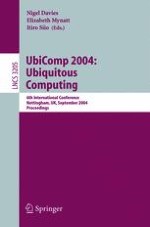2004 | Book
UbiComp 2004: Ubiquitous Computing
6th International Conference, Nottingham, UK, September 7-10, 2004. Proceedings
Editors: Nigel Davies, Elizabeth D. Mynatt, Itiro Siio
Publisher: Springer Berlin Heidelberg
Book Series : Lecture Notes in Computer Science
Included in: Professional Book Archive
